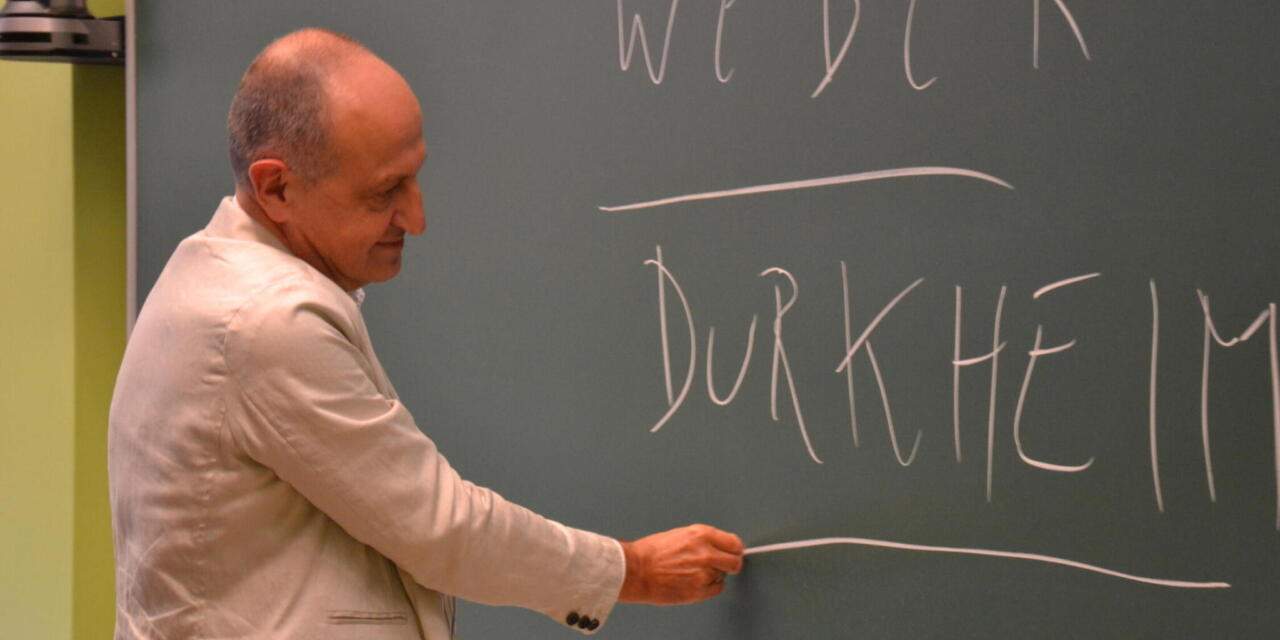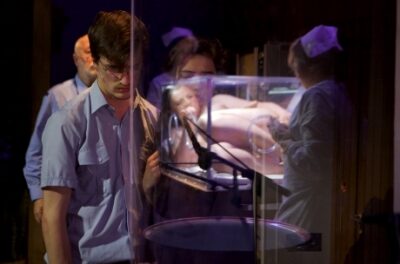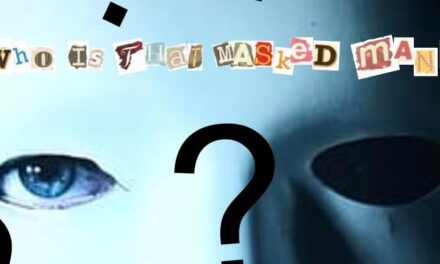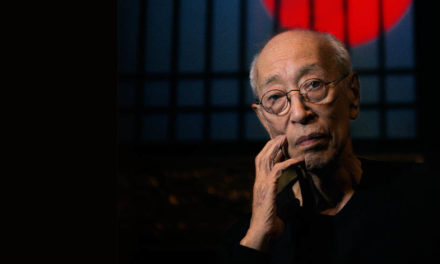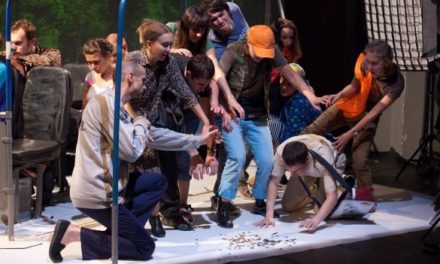This is Part II of the essay. To read Part I, click here.
8. (ON A-HUMANISM, AGAIN)
A-humanism is not just a theoretical axiom but first and foremost an experience. Who speaks? Who writes? Who thinks? – Who dances? The results of speaking, writing, thinking, dancing will be attributed to an author – a subject, an I, a person having self-consciousness, a will and intentions. This individualization of speaking (etcetera) is a social and moral necessity or, rather, a necessary fiction to produce moral responsibility and to prevent social life from becoming too complex. (It also follows partly from the syntax of language: “I speak” – and, whoops, there is the suggestion of an “I” causing the speaking).
And a fiction it is. Everybody knows from first-hand experience that thoughts, words, or movements do not have a clear origin. They just happen to arrive in the metaphorical space associated with the word consciousness or body. It’s indeed more correct to state that one speaks, one writes, one thinks, one dances – with the individual consciousness or body just acting, and only partially so, as a controlling and correcting observer of what arrives to one, to some body, to somemind. ‘I’, the subject, is second to – and seconds – what becomes. And where does that becoming come from?
We can only speculate on the ground (subiectum) that bears us when speaking, writing, dancing – on the otherness undoing me when I do. The results of this thinking are the stuff theory classes are made of: elaborations on language or habit formation, concepts like the unconsciousness, discourse, system or potentiality, not to mention Being (with a capital letter). Or Life (also with a capital letter). There is yet another candidate knocking on the door: the brain, the neurological system. The day that someone’s brain self-reflexively understands itself will be the day that Hegel’s dream of the Absolute Spirit becomes true, and all my theory books will be deemed rubbish.
And yet, also after that day I will see individuals dancing: because giving meaning differs from explaining; because authorizing activities will remain a necessary social and moral fiction; because the brain will not suddenly refrain from speculating when it self-reflexively understands the underlying mechanisms of jam-session thinking; because – this is the crucial point – even if the brain may only produce consciousness as a necessary interface between its own neurological reality and the reality out there, it still realizes itself through language.
When everything is explained, meaning and the desire for meaning remain the enigma they were, are and will be.
9. (ON ART/DANCE CRITICISM, PART ONE)
One sees a dance performance; one comes home and writes a review. Two acts are involved – viewing and reviewing – to perceive and being affected on the one hand and to work with the memories of those percepts and affects on the other hand. The viewing is not in the reviewing: there exists an irreparable fissure between both acts.
Let’s agree that the reviewer is not just giving consumer advise but is an essayist: someone trying (the literal meaning of essayer) to understand her viewing. The space of genuine criticism is the space of “essayism”: reflexively dealing with the memories of sensations elicited by one or more works one tries to understand, to interpret, to give meaning.
The critic indeed operates with and on archives. Writing on art – for what I say here on art criticism also goes for art theorizing – starts from reminiscences of an experience that is not ‘just subjective’ since it first and foremost consists of pre-subjective percepts and affects mutually battling to become conscious. When reviewing, one works with the interaction between the conscious condensations of these sensations and their resonance in a partly conscious, partly unconscious archive consisting of traces of previous experiences in the sphere of the arts, traces of book readings, of concepts, of talks. Each body is an archive of archives (an “an-archive”); like every artist, an art writer is operated by that archive – for you don’t chose the resonances between what you’ve seen and the remnants your personal cultural history.
10. (ON ART/DANCE CRITICISM, PART TWO)
Every artwork is a unique riddle; the critic tries to solve the puzzle – knowing that this is impossible. The basic rule of art criticism (and again also of art theorizing) stipulates that you try to do the impossible by doing it as if it is possible. Only in that way may one write something meaningful superseding cliché-talk such as “it was interesting.” The critic saying that art equals ineffable, unspeakable experiences should be criticized for being incapable of performing the impossible as a possible shortcoming.
The riddle that every artwork is, cannot be unravelled – of course not. The stake of criticism is to show that the riddle is a riddle and not just an arbitrary mixture of for instance movements, gestures, poses.
Interpretative writing obliges one to logical linearity, to discursivity, to a minimum of argumentation – all qualities that deny the capricious nature of experiencing or thinking, not to say anything of dancing. Yet its principal effect is the “textualization” of what the text is about. One gives meaning, thus turning the artwork into a book. The critic is indeed first and foremost a reader presupposing there is something to understand. Whereas the viewer was fascinated by signifiers, the reviewer is obsessed by their signification: she wants to tame the signifiers’ excessive character. And yet precisely this operation completes the art experience. Only sensually experiencing an artwork is missing the experience of it.
“In order to be experienced completely, every artwork needs thought and philosophy (theory – RL), which is nothing else than thinking that resists being hampered,” thus Theodor W. Adorno rightly contends.[1]Theodor W. Adorno, Ästhetische Theorie. Frankfurt am Main: Suhrkamp, 1996, p. 393 (own translation). There’s a crucial reference here to speculative thinking. The critic indeed speculates on the possible meanings of the riddle. To speculate: to meditate on, to ponder over, to reflect on or to reflect upon, to chew over, to think over, to excogitate, to contemplate, to muse, to mull over, to ruminate, to conjecture, to hypothesize… and, yes, to theorize.
There’s yet another effect of the necessary act of textualization accompanying interpretation in art writing, which is particularly reproduced in dance writing: the overlooking of the looked at bodies. They transform into passive, even invisible bearers of the choreographic message; they work but are reduced to quantité négligable when it comes to a dance work’s overall meaning. All reification is a forgetting,” Max Horkheimer and Theodor W. Adorno assert[2]Max Horkheimer and Theodor W. Adorno, Dialectic of Enlightenment: Philosophical Fragments. Stanford, CA: Stanford University Press, 2002, p. 191. – and what is forgotten in textualism is the autonomous materiality of the text, the physical work sustaining the work, the performers producing the performativity one applauds. Their bodies are ‘excribed’ when the dance is described, analysed, interpreted. Is this unavoidable?
11. (ON ART/DANCE CRITICISM, PART THREE)
The artwork’s uniqueness makes – in Kant’s well-known terminology – a determinate judgment impossible: an artwork’s valuation cannot be based on general standards or concepts. However, an artwork’s interpretation may contain bits and pieces of theorizing or theory.
Theory not only enables one to ennoble a piece; it’s first and foremost a tool to generalize the stake of an artwork. Concepts resemble money: through their abstract nature, they act as standards of equivalence, allowing comparisons with other works, situations, actions.
Thus, a concept such as “the distribution of the sensible” (Jacques Rancière) opens up a background that foregrounds a work’s general qualities and gives it an exemplary value.[3]Jacques Rancière, The Politics of Aesthetics: The Distribution of the Sensible. London: Continuum, 2004. To prevent the work’s devaluation into a contingent illustration of the invoked concept, the critic must point out in detail where that very concept meets the work. This involves painful labour art critics or theorists often eschew (I know what I’m talking of: I’m guilty).
12. (ON THE ‘POLITICALITY’ OF ART/DANCE)
The socio-political dimension of all art regards the compositional relationship between the general and the particular, the work as a totality and the constituting elements, its rational conception and its material components eliciting various sensations.[4]This idea is a core idea in Adorno’s aesthetic theory but implicitly also characterises Niklas Luhmann’s art theory. See Adorno, a.w., and Niklas Luhman, Die Kunst der Gesellschaft. Frankfurt am … Continue reading In dance, this distinction is traditionally grasped as the relationship between the choreography and the selected movements, gestures, poses or whatever actions the score organizes. The general compositional logic associated with the notion of choreography stands for the grip of reason and, especially, of power onto the individual elements. It’s an organizational, even administrative logic implying an exercise of power that is only partially expressed in the inequal social division of labour between choreographer and performers (and that will not disappear, only be differently arranged, in more collaborative modes of producing a work).
Composing equals writing in the general sense, which of course includes choreography; writing in the general sense operates with one or more materials (media) that it decomposes into sensible elements (signifiers: “letters”) on which it subsequently imposes a grammar, a syntax, a structure. Does the writing make room for an emancipation of the components? Does it allow the possibility of excessive signifiers? Does it offer the chance of particularization, always implying a specific “sensualization,” to colours and lines, tones and sounds, movements and standstills? These are the kind of questions circumscribing the “politicality” of an artwork.
I deliberately do not refer to individuals as elements or components of, for instance, a dance work. A society, and hence a dance company, does not consist of individuals but – as was already suggested – of the at once generic and individualised potentials to speak, think, imagine, feel and move. A free society is one in which these capacities – these powers – are free to associate and radiate. No anarchism implied, quite the contrary. For what is required is not a freedom from organization but an organizational setting offering dispersed potentials the possibility to associate in such a way that a momentary coherence or consistency may be found or, rather, can be actively constructed through experimentation: this is the stake of every form of emancipatory politics.[5]This view is much indebted to the work of Oskar Negt & Alexander Kluge, and also to the many talks I had with dancers on artistic collaboration. See, for instance, Oskar Negt & Alexander … Continue reading
All genuine politics, whatever the medium, is a specific kind of composing and choreographing: constructing and trying out consistencies among whatever kind of elements in such a way that they can excel excessively in order to cohere in hitherto unthinkable ways.
13. (ON INTELLIGENT ART)
I once coined the notion of reflexive dance when referring to dance works that consider in full range the constitutive elements of a dance work. So not just, for instance, the performed movements but also the structuring role of lighting, the spatiality of the stage or the audience’s shadow existence (which mostly hovers between visibility and non-visibility, and also between attention and sleepiness).[6]10. Laermans, a.w., pp. 192-211. Only later I realized that the expression – which was meant to be an alternative for the awkward notion of conceptual dance – could also be used in a more literal sense, as referring to dance works that incorporate knowledge about themselves and, in a broader sense, theory or – formulated in a more mundane way – knowledge stemming from the reading of books. However, this can be done in several ways. For the sake of clarity, I propose two ideal-types.
Either one can show how smart one is, with or without textual quotes, but in any case with a visible surplus of intellectuality that often just replaces the old-fashioned bourgeois idea of depth – of a deep meaning. Or the reflexivity has soaked into everything visible, audible, or happening, giving the work a particular intelligibility and transforming it into something intelligent.
Intelligent art works are rare. It’s rather easy to make an engaged statement in whatever medium on whatever pressing issue; it’s quite difficult to make a work in which, phrased in traditional terms, form has taken over content because content has taken over form, with form and content yet remaining a quarrelling disunity.
In the realm of performance, one recurrent (not absolute) indicator of intelligence is that the doers know what they are doing – but non-subjectively. The attentive way a movement is made, be it a slow or a quick one, may testify to a razorblade sharpness and depersonalized lucidity that positions the performer beyond herself. In that icy “beyond,” intelligence finds its definition and shakes hands with audacity.
14. (A DANCE DREAM INSPIRED BY THE IDEA THAT THE ONLY INTERESTING DIALECTIC IS THE FIGURE OF THE UNRESOLVABLE PARADOX)
According to the Merriam-Webster Dictionary, to abstain means to choose not to do or have something; to refrain deliberately and often with an effort of self-denial from an action or practice.
The definition in the American Heritage Dictionary of the English Language is somewhat sharper: to hold oneself aloof, to forbear or refrain voluntarily, and especially from an indulgence of the passions or appetites.
Imagine someone having a genuine passion for dance and dancing;
imagine that person refraining from dancing while dancing;
imagine, in other words, what a dance abstaining from dance may look like;
imagine, in other words, a movement moving away from movement.
Call it abstaining dance: to exit dance through dancing;
call it withdrawal dance: “I’m just here because I’m leaving”;
call it gesturing dance: “I dancingly wave goodbye to dance.”
This article was originally published by E-tcetera on May 14, 2022, and has been reposted with permission. To read the original article, click here.
This post was written by the author in their personal capacity.The opinions expressed in this article are the author’s own and do not reflect the view of The Theatre Times, their staff or collaborators.
This post was written by Rudi Laermans.
The views expressed here belong to the author and do not necessarily reflect our views and opinions.
Notes
| ↑1 | Theodor W. Adorno, Ästhetische Theorie. Frankfurt am Main: Suhrkamp, 1996, p. 393 (own translation). |
|---|---|
| ↑2 | Max Horkheimer and Theodor W. Adorno, Dialectic of Enlightenment: Philosophical Fragments. Stanford, CA: Stanford University Press, 2002, p. 191. |
| ↑3 | Jacques Rancière, The Politics of Aesthetics: The Distribution of the Sensible. London: Continuum, 2004. |
| ↑4 | This idea is a core idea in Adorno’s aesthetic theory but implicitly also characterises Niklas Luhmann’s art theory. See Adorno, a.w., and Niklas Luhman, Die Kunst der Gesellschaft. Frankfurt am Main: Suhrkamp, 1995. |
| ↑5 | This view is much indebted to the work of Oskar Negt & Alexander Kluge, and also to the many talks I had with dancers on artistic collaboration. See, for instance, Oskar Negt & Alexander Kluge, Massverhältnisse des Politischen: Vorschläge zum Unterscheidungsvermögen. Göttingen: Steidl, 2016 and the second part, addressing collaboration in contemporary dance, in Rudi Laermans, Moving Together: Theorizing and Making Contemporary Dance. Amsterdam: Valiz, 2015, pp. 246-396. |
| ↑6 | 10. Laermans, a.w., pp. 192-211. |

